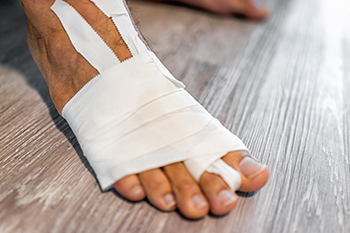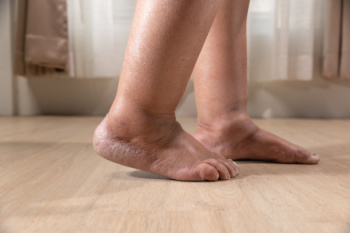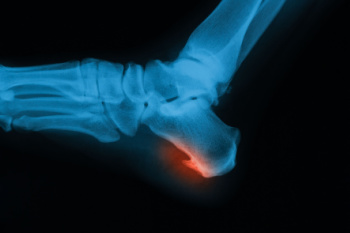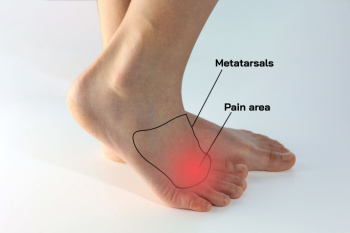August 2024
It's Time for Beautiful Feet
What Is Turf Toe?

Turf toe is a sprain of the ligaments surrounding the big toe joint, typically occurring in athletes who play on artificial turf, though it can affect anyone engaged in activities that involve pushing off the big toe forcefully. Turf toe is usually caused by repetitive hyperextension of the big toe, often when an athlete or dancer pushes off the ground. The injury is classified into three grades. Grade 1 involves mild stretching of the ligaments, causing minor pain and swelling. Grade 2 includes partial tearing, leading to moderate pain, bruising, and difficulty in movement. Grade 3 is a complete tear, resulting in severe pain, significant swelling, and joint instability. Symptoms of turf toe include pain, swelling, and limited range of motion in the big toe. Diagnosis is made through a physical exam and imaging studies like X-rays. Treatment varies by grade, ranging from rest for milder cases to immobilization or surgery for severe injuries. If you are suffering with what you think might be turf toe, it is suggested that you consult a podiatrist for a proper diagnosis and treatment.
Sports related foot and ankle injuries require proper treatment before players can go back to their regular routines. For more information, contact Dr. Lee R. Stein of Lake Shore Foot & Ankle, PC. Our doctor can provide the care you need to keep you pain-free and on your feet.
Sports Related Foot and Ankle Injuries
Foot and ankle injuries are a common occurrence when it comes to athletes of any sport. While many athletes dismiss the initial aches and pains, the truth is that ignoring potential foot and ankle injuries can lead to serious problems. As athletes continue to place pressure and strain the area further, a mild injury can turn into something as serious as a rupture and may lead to a permanent disability. There are many factors that contribute to sports related foot and ankle injuries, which include failure to warm up properly, not providing support or wearing bad footwear. Common injuries and conditions athletes face, including:
- Plantar Fasciitis
- Plantar Fasciosis
- Achilles Tendinitis
- Achilles Tendon Rupture
- Ankle Sprains
Sports related injuries are commonly treated using the RICE method. This includes rest, applying ice to the injured area, compression and elevating the ankle. More serious sprains and injuries may require surgery, which could include arthroscopic and reconstructive surgery. Rehabilitation and therapy may also be required in order to get any recovering athlete to become fully functional again. Any unusual aches and pains an athlete sustains must be evaluated by a licensed, reputable medical professional.
If you have any questions please feel free to contact one of our offices located in Chicago, Highland Park, and Uptown, IL . We offer the newest diagnostic and treatment technologies for all your foot and ankle needs.
Causes of Swollen Feet From Daily Activities

Swollen feet, or edema, can result from various factors. Spending long hours on your feet, such as during extended work shifts or prolonged standing, can cause fluid to accumulate in the lower extremities. Excessive salt intake contributes to fluid retention, exacerbating swelling. Injuries, such as sprains or fractures, often lead to localized swelling as part of the body's inflammatory response. Pregnancy also commonly causes swollen feet due to increased blood volume and pressure on the veins. Each of these causes affects fluid balance and circulation, leading to discomfort and visible swelling. If you notice your ankles and feet have become swollen, it is suggested that you contact a podiatrist who can accurately determine the cause, and offer you effective relief methods.
Swollen feet can be a sign of an underlying condition. If you have any concerns, contact Dr. Lee R. Stein of Lake Shore Foot & Ankle, PC. Our doctor can provide the care you need to keep you pain-free and on your feet.
Swollen feet are a common ailment among pregnant women and people who stand or sit for extended periods. Aging may increase the possibility of swollen feet and patients who are obese often notice when their feet are swelling too. There may be medical reasons why swollen feet occur:
- Phlebitis - A condition that causes the veins to become inflamed and can also cause leg pain.
- Liver disease - This may lead to low blood levels of albumin which is a protein. This can cause fluid in the blood to pass into the tissues and several areas of the body can become swollen.
- Heart failure - When the heart doesn’t pump properly the blood that is normally pumped back to the heart can pool in the veins of the legs causing swollen feet.
- Kidney disease - One of the main functions of the kidneys is releasing excess fluid in the body. This type of condition can make it difficult for the kidneys to function properly, and as a result the feet may become swollen.
- Deep-vein thrombosis (DVT)- This is a serious condition where blood clots form in the veins of the legs. They can block the return of blood from the legs to the heart which may cause the feet to swell. It is important to be treated by a podiatrist if this condition is present.
Swollen feet can also be caused by bone and tendon conditions, including fractures, arthritis, and tendinitis. Additionally, there may be skin and toenail conditions and an infection may cause the feet to swell. Patients who take medicine to treat high blood pressure may be prone to getting swollen feet.
Many patients elevate their feet to help relieve the swelling and this is generally a temporary remedy. When a podiatrist is consulted the reason behind the swelling can be uncovered and subsequently treated.
If you have any questions please feel free to contact one of our offices located in Chicago, Highland Park, and Uptown, IL . We offer the newest diagnostic tools and technology to treat your foot and ankle needs.
What Is Cuboid Syndrome?
 Cuboid syndrome is a condition where the cuboid bone in the foot becomes partially dislocated or misaligned, causing pain and discomfort. It often results from an injury or overuse, particularly in athletes or individuals who engage in activities involving repetitive stress on the feet, such as running or jumping. Symptoms include pain on the lateral side of the foot, difficulty walking, and swelling or tenderness surrounding the cuboid bone. Diagnosis is typically made through physical examination and medical history, as it may not always appear on standard imaging tests. Treatment involves realigning the cuboid bone, which can be done through manipulation techniques performed by a podiatrist. Additional treatments can include rest, compression, elevation, and supportive footwear, or orthotics to alleviate stress on the affected area. If you have pain on the lateral side of your foot, it is suggested that you schedule an appointment with a podiatrist for a proper diagnosis and treatment.
Cuboid syndrome is a condition where the cuboid bone in the foot becomes partially dislocated or misaligned, causing pain and discomfort. It often results from an injury or overuse, particularly in athletes or individuals who engage in activities involving repetitive stress on the feet, such as running or jumping. Symptoms include pain on the lateral side of the foot, difficulty walking, and swelling or tenderness surrounding the cuboid bone. Diagnosis is typically made through physical examination and medical history, as it may not always appear on standard imaging tests. Treatment involves realigning the cuboid bone, which can be done through manipulation techniques performed by a podiatrist. Additional treatments can include rest, compression, elevation, and supportive footwear, or orthotics to alleviate stress on the affected area. If you have pain on the lateral side of your foot, it is suggested that you schedule an appointment with a podiatrist for a proper diagnosis and treatment.
Cuboid syndrome, also known as cuboid subluxation, occurs when the joints and ligaments near the cuboid bone in the foot become torn. If you have cuboid syndrome, consult with Dr. Lee R. Stein from Lake Shore Foot & Ankle, PC. Our doctor will assess your condition and provide you with quality foot and ankle treatment.
Cuboid syndrome is a common cause of lateral foot pain, which is pain on the outside of the foot. The condition may happen suddenly due to an ankle sprain, or it may develop slowly overtime from repetitive tension through the bone and surrounding structures.
Causes
The most common causes of cuboid syndrome include:
- Injury – The most common cause of this ailment is an ankle sprain.
- Repetitive Strain – Tension placed through the peroneus longus muscle from repetitive activities such as jumping and running may cause excessive traction on the bone causing it to sublux.
- Altered Foot Biomechanics – Most people suffering from cuboid subluxation have flat feet.
Symptoms
A common symptom of cuboid syndrome is pain along the outside of the foot which can be felt in the ankle and toes. This pain may create walking difficulties and may cause those with the condition to walk with a limp.
Diagnosis
Diagnosis of cuboid syndrome is often difficult, and it is often misdiagnosed. X-rays, MRIs and CT scans often fail to properly show the cuboid subluxation. Although there isn’t a specific test used to diagnose cuboid syndrome, your podiatrist will usually check if pain is felt while pressing firmly on the cuboid bone of your foot.
Treatment
Just as the range of causes varies widely, so do treatments. Some more common treatments are ice therapy, rest, exercise, taping, and orthotics.
If you have any questions, please feel free to contact one of our offices located in Chicago, Highland Park, and Uptown, IL . We offer the newest diagnostic and treatment technologies for all your foot care needs.
Understanding Morton’s Neuroma
 Morton's neuroma is a painful foot condition caused by the thickening of the tissue surrounding the nerves leading to the toes, usually between the third and fourth toes. This condition often results from repetitive stress or wearing tight, high-heeled, or narrow shoes, leading to nerve irritation. Symptoms can include burning pain in the ball of the foot, tingling, or numbness in the toes, and discomfort that worsens with walking, standing, or wearing constricting footwear. Diagnosis involves a physical examination, with imaging tests like ultrasounds or MRI scans used to rule out other conditions. Treatment focuses on relieving pressure on the affected nerve. Initial approaches include switching to wider shoes, using orthotic devices, and taking anti-inflammatory medications. In more severe cases, corticosteroid injections or surgical removal of the thickened tissue may be necessary. If you feel you may have Morton's neuroma, it is suggested that you schedule an appointment with a podiatrist for a proper diagnosis and treatment.
Morton's neuroma is a painful foot condition caused by the thickening of the tissue surrounding the nerves leading to the toes, usually between the third and fourth toes. This condition often results from repetitive stress or wearing tight, high-heeled, or narrow shoes, leading to nerve irritation. Symptoms can include burning pain in the ball of the foot, tingling, or numbness in the toes, and discomfort that worsens with walking, standing, or wearing constricting footwear. Diagnosis involves a physical examination, with imaging tests like ultrasounds or MRI scans used to rule out other conditions. Treatment focuses on relieving pressure on the affected nerve. Initial approaches include switching to wider shoes, using orthotic devices, and taking anti-inflammatory medications. In more severe cases, corticosteroid injections or surgical removal of the thickened tissue may be necessary. If you feel you may have Morton's neuroma, it is suggested that you schedule an appointment with a podiatrist for a proper diagnosis and treatment.
Morton’s neuroma is a very uncomfortable condition to live with. If you think you have Morton’s neuroma, contact Dr. Lee R. Stein of Lake Shore Foot & Ankle, PC. Our doctor will attend to all of your foot care needs and answer any of your related questions.
Morton’s Neuroma
Morton's neuroma is a painful foot condition that commonly affects the areas between the second and third or third and fourth toe, although other areas of the foot are also susceptible. Morton’s neuroma is caused by an inflamed nerve in the foot that is being squeezed and aggravated by surrounding bones.
What Increases the Chances of Having Morton’s Neuroma?
- Ill-fitting high heels or shoes that add pressure to the toe or foot
- Jogging, running or any sport that involves constant impact to the foot
- Flat feet, bunions, and any other foot deformities
Morton’s neuroma is a very treatable condition. Orthotics and shoe inserts can often be used to alleviate the pain on the forefront of the feet. In more severe cases, corticosteroids can also be prescribed. In order to figure out the best treatment for your neuroma, it’s recommended to seek the care of a podiatrist who can diagnose your condition and provide different treatment options.
If you have any questions, please feel free to contact one of our offices located in Chicago, Highland Park, and Uptown, IL . We offer the newest diagnostic and treatment technologies for all your foot care needs.
Blog Archives
- March 2025
- February 2025
- January 2025
- December 2024
- November 2024
- October 2024
- September 2024
- August 2024
- July 2024
- June 2024
- May 2024
- April 2024
- March 2024
- February 2024
- January 2024
- December 2023
- November 2023
- October 2023
- September 2023
- August 2023
- July 2023
- June 2023
- May 2023
- April 2023
- March 2023
- February 2023
- January 2023
- December 2022
- November 2022
- October 2022
- September 2022
- August 2022
- July 2022
- June 2022
- May 2022
- April 2022
- March 2022
- February 2022
- January 2022
- December 2021
- November 2021
- October 2021
- September 2021
- August 2021
- July 2021
- June 2021
- May 2021
- April 2021
- March 2021
- February 2021
- January 2021
- December 2020
- November 2020
- October 2020
- September 2020
- August 2020
- July 2020
- June 2020
- May 2020
- April 2020
- March 2020
- February 2020
- January 2020
- December 2019
- November 2019
- October 2019
- September 2019
- August 2019
- July 2019
- June 2019
- May 2019
- April 2019
- March 2019
- February 2019
- January 2019
- December 2018
- November 2018
- October 2018
- September 2018
- August 2018
- July 2018







